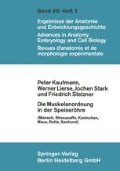Abstract
The muscle arrangement in the esophagus of man, rhesus, rabbit, mouse, rat and sea-dog was researched by optical polarisation and histological methods. The results: It was found that two principal muscle constructions of the esophagus existed:
-
1.
The “winding”; groups of smooth or sceletal musce fibers course from cranial to caudal with just the same distance from the lumen, revolving it clockwise in steep figures with constant gradation.
-
2.
The “screw”; the groups of muscle fibers turn round the lumen, similar to the cochleated figures and approach the lumen with decreasing gradation.
Access this chapter
Tax calculation will be finalised at checkout
Purchases are for personal use only
Author information
Authors and Affiliations
Rights and permissions
Copyright information
© 1968 Springer-Verlag Berlin Heidelberg
About this paper
Cite this paper
Kaufmann, P., Lierse, W., Stark, J., Stelzner, F. (1968). Summary. In: Die Muskelanordnung in der Speiseröhre. Ergebnisse der Anatomie und Entwicklungsgeschichte / Advances in Anatomy, Embryology and Cell Biology / Revues d’anatomie et de morphologie expérimentale, vol 40/3. Springer, Berlin, Heidelberg. https://doi.org/10.1007/978-3-662-11519-0_6
Download citation
DOI: https://doi.org/10.1007/978-3-662-11519-0_6
Publisher Name: Springer, Berlin, Heidelberg
Print ISBN: 978-3-540-04087-3
Online ISBN: 978-3-662-11519-0
eBook Packages: Springer Book Archive

